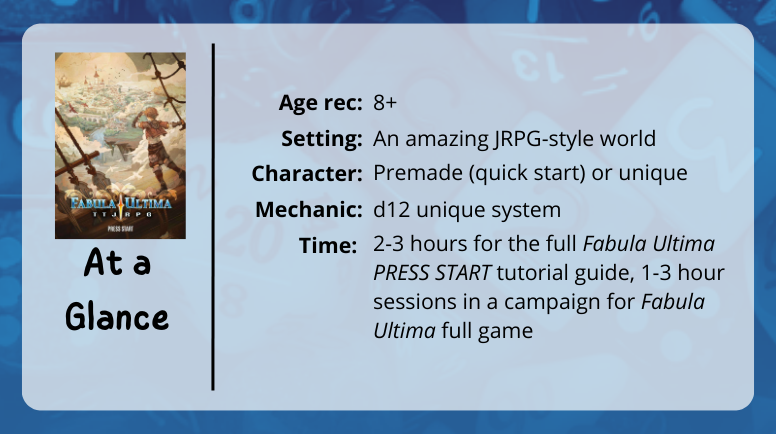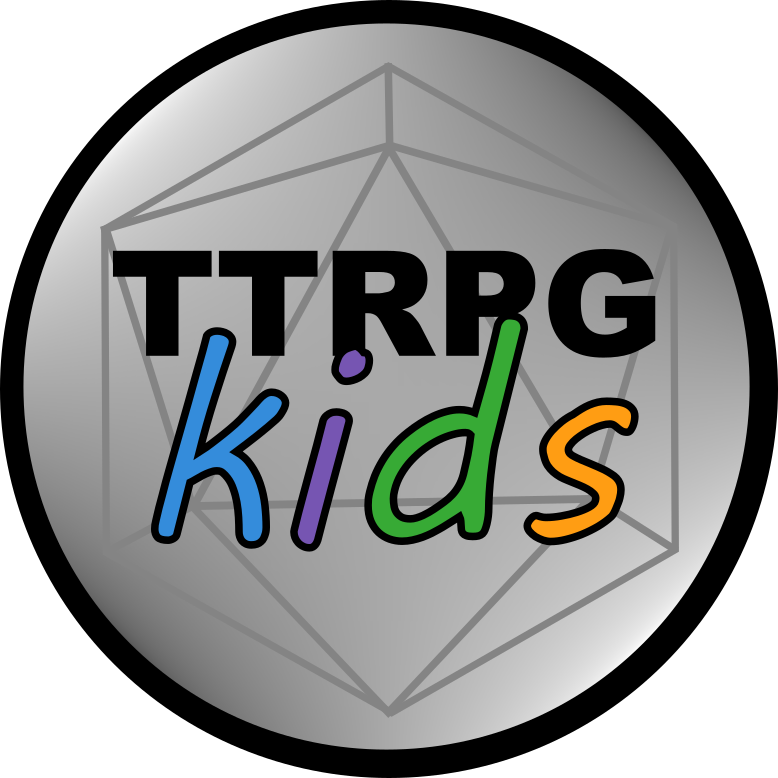Review of Fabula Ultima PRESS START TTJRPG
Note: This post may contain affiliate links. At no additional cost to you, I may earn a small commission from purchases made using them. TTRPGkids uses this to keep the site going. Read full disclosure here.
Jump to:

Fabula Ultima PRESS START is great for ages 8+
Fabula Ultima PRESS START is the quick start guide and tutorial for the Fabula Ultima TTJRPG book. For this review, my focus is on the quick start guide, which I’m rating for players about age 8 and up.

The content in PRESS START is on par with a lot of the action in JRPGs – there’s some exciting drama from a crashing airship, exploration, a mob encounter, and a boss fight to run you through the different mechanics and practice role-playing. You can control the descriptions and dialogue during fights and “cutscenes” to tailor to your players, like a sliding scale that lets you adjust the vibe from Legend of Zelda to NiNoKuni to Final Fantasy.
For being able to grasp the mechanics, PRESS START does a wonderful job of walking players through the system, unlocking new parts of the character sheet as you progress to each chapter so you have time to learn and practice using different elements of your character. Especially for newer and younger TTRPG players, I love it when games do this because it guides the learning process in a very natural way and alleviates the pressure from both the players to learn everything up front and the GM to teach players as they go… and this is one of the best examples of how to use this method well.
Fabula Ultima PRESS START is set in a JRPG world of adventure
Fabula Ultima, being a TTJRPG, has many similar setting elements to video game JRPGs! There’s magic, mechs, airships, kingdoms in conflict, mysterious artifacts, and strange and wondrous creatures spread throughout the world. It captures the feel of playing a JRPG through a combination of the story, characters, and art, and it would be a great bridge from video games to tabletop games for any JRPG fan.
Your character in Fabula Ultima PRESS START

In PRESS START, you are given four premade characters to use through the tutorial adventure while learning about the game. These characters include Blair, heir to the throne, Cassandra, former skyrider captain, Edgar, a young inventor, and Lavigne, the princess of a defeated kingdom. Between these four characters, you have a wide range of magical, technical, and tactical abilities to try out while practicing the game’s mechanics, and they each have great backstories that tie into the adventure, giving both the GM and players examples of character building and a base for role-playing.
When making your own characters, the character sheet fits on two digest sized pages (so it’s all visible in one full spread) where you’ll be able to track everything from key attributes, your bond with other characters, HP and MP, skills, equipment, and more. Different sections of the character sheet are well separated and have space for writing in details for your moves, so it’s easy to quickly find what you’re looking for and track it all in one spot.
Mechanics in Fabula Ultima PRESS START
Learn-as-you-go streamlined JRPG mechanics
As I said in the age recommendation section, PRESS START teaches you how to play as you go, meaning that you can learn a lot of different mechanics a little bit at a time; you can handle some complexity and still make it feel very rules-lite. Fabula Ultima has a little bit of complexity to it so you have customizability that is often present in JRPGs, but it’s also streamlined to make it an accessible tabletop game.
The stats for all your equipment are clearly and concisely marked, there’s check boxes and stat trees to help with tracking conditions, inventory management is done with a point buy system so you don’t have a big clunky bag of items to track, and there’s a very reasonable number of special skills so players have options but aren’t getting overwhelmed.
Rolling some dice
Attributes and moves in Fabula Ultima are rolled for using two dice so you can get a wide variety of skill combos by only tracking four main stats (Dexterity, Insight, Might, and Willpower) that each have an assigned die (between d6 and d12). So, if you want to do a big jump, you’ll roll two dice, your one for Dexterity and your one for Might, then add them to see if you pass the check. If something is clearly just one skill (like reading a conversation might be just Insight), you roll that die twice and add the two results just like if you were rolling two separate attributes.
This gets rid of a lot of the arguments about whether a jump should be a dexterity-based or strength-based roll or if holding your breath is more about your physical capabilities versus your willpower – those in-between skills can be both! By having the dice combo mechanic, you also get 20 different combinations while only needing to track and remember four stats.
When it comes to making moves like swinging a sword or firing a weapon, your equipment has the dice roll combo clearly labeled with what two attributes you’ll use for accuracy (seeing if it hits), then you take the highest of the two dice plus one modifier to use for calculating damage. There’s no extra rolls or big numbers to add up – it’s streamlined but unique with plenty of room for strategizing during character build.
Fabula Hero Points and Ultima Villain Points

One part of Fabula Ultima that I particularly liked was how failed rolls and drama give bonuses, so it really entices players to continue to seek out adventure (and maybe be more OK with getting into trouble). Every time you fumble on a check, you get a Fabula Point for your character as they learn from their mistakes, and every time a new villain comes into the story, ALL players gain a Fabula Point to prepare for the incoming conflict.
Fabula Points can be spent to give you some pretty big bonuses on critical checks later in the game, so they’re a fantastic way to encourage players to keep moving forward and equip them with what they need to handle big situations.
On the flip side of that… the villains also have their own point pool. These are Ultima Points, and they allow villains to boost their checks, recover mid battle, or flee from our heroes if the situation starts to get dire. Having the villain also using a similar mechanic makes conflicts feel more balanced, and it’s also a lot easier for a player to eventually take a GM role.
Overall thoughts on Fabula Ultima PRESS START
Fabula Ultima PRESS START is an amazing intro to TTRPGs with its streamlined mechanics walkthrough and connection to other existing interests. It really feels like a bright, dramatic, and engaging JRPG brought to the physical game table. It’s beautifully illustrated, has an amazing layout, and is thoughtfully put together in a way that puts player and GM accessibility at the forefront.
This was such a joy to check out, and I definitely geeked out with another creator about it for a couple hours while running a booth at a convention earlier this year. Especially with the quick start guide PDF being free, I really recommend getting a copy whether you are playing TTRPGs with kids, want a great example for building game mechanics, or just like JRPG-vibes!
Find a copy of Fabula Ultima PRESS START
You can find a copy of Fabula Ultima PRESS START here on DriveThruRPG (digital) and NEED GAMES (physical)!
You can also find the full version of Fabula Ultima here on DriveThruRPG (digital) and NEED GAMES (physical)!
If you liked this post, make sure to subscribe to the TTRPGkids monthly newsletter to stay up to date on the latest reviews, tips and tricks, game and podcast list updates, and more! Thank you for playing tabletop RPGs with your kids and sharing this awesome hobby with the next generation!



Do you have any thoughts on whether or not minis and maps can/should/shouldn’t be involved? I guess more to the point is it written with that consideration or is it aimed squarely at theatre of the mind?
Hello! I think it can go either way with maps and minis on this one. When we tried out PRESS START, we did all theater of the mind because that’s what we do about 70% of the time/we’re pretty used to that, and it didn’t require tracking distances (at least in PRESS START). Think like… FF8 with your characters lined up in front of the baddies. That said, I think a map and minis could help with visualizing the scene, keeping track of the baddies (especially if there’s 3+ to think about), and with RP (if you want to move or describe motion, interesting terrain, etc).